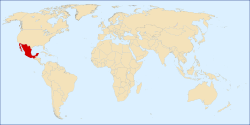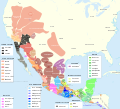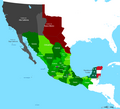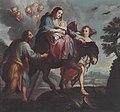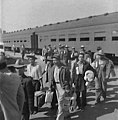Portal:Mexico
|
The Temple of Warriors at Chichen Itza, Mexico
¡Bienvenido! Welcome to the Mexico portal
Mexico, officially the United Mexican States, is a country in the southern portion of North America. It covers 1,972,550 km2 (761,610 sq mi), making it the world's 13th-largest country by area; with a population of almost 130 million, it is the 10th-most-populous country and the most populous Spanish-speaking country. Mexico is organized as a federal constitutional republic comprising 31 states and Mexico City, its capital. It shares land borders with the United States to the north, with Guatemala and Belize to the southeast; as well as maritime borders with the Pacific Ocean to the west, the Caribbean Sea to the southeast, and the Gulf of Mexico to the east.
This is a Featured article, which represents some of the best content on English Wikipedia.
The Convention of 1832 was the first political gathering of colonists in Mexican Texas. Delegates sought reforms from the Mexican government and hoped to quell the widespread belief that settlers in Texas wished to secede from Mexico. The convention was the first in a series of unsuccessful attempts at political negotiation that eventually led to the Texas Revolution. Under the 1824 Constitution of Mexico, Texas was denied independent statehood and merged into the new state Coahuila y Tejas. After growing suspicion that the United States government would attempt to seize Texas by force, in 1830 Mexican President Anastasio Bustamante enacted the Law of April 6, 1830 which restricted immigration and called for customs duty enforcement. Tensions erupted in June 1832, when Texas residents systematically expelled all Mexican troops from eastern Texas. (Full article...)Selected article -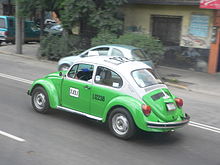 The Volkswagen Beetle was introduced to Mexico in March 1954, inside the exhibition "Alemania y su Industria" (Germany and its Industry). Four different Volkswagen vehicles were brought to Mexico through Veracruz City for the first time. Those vehicles were: two Sedans 113 in "Export" trim, a convertible, and a VW Bus in luxury trim. Officially, the Bug/Beetle was named "Type I sedan" and the Bus was named "Type II station wagon", though variants included single and double cab pickups. At that time, the Mexican car market was mostly characterized by American makes and models with large sizes and large engines, which made a huge contrast with the new German entrant. An exhibition was held in the Ciudad Universitaria in Mexico City; during this event, the vehicles were widely admired by the public. The Volkswagen Beetles displayed there were the model with the "oval window". Former Mexican president Lázaro Cárdenas made a trip from Michoacán, just to see this peculiar vehicle. The local press immediately published the news into eight columns under the title "The People's Man" with the "People's Car". (Full article...)Selected picture El último beso (The Last Kiss) (1916), by Francisco Romano Guillemín, at the Museo Nacional de Arte image credit: public domain
This is a Good article, an article that meets a core set of high editorial standards.
Mis Romances (English: My Romances) is the fourteenth studio album of Mexican singer Luis Miguel, released on 20 November 2001 by Warner Music Latina. It is the fourth album in the Romance series wherein Luis Miguel covers bolero standards from Latin America and includes two original compositions. Produced by Luis Miguel, the album was recorded at the Record Plant in Los Angeles, California with the participation of the Royal Philharmonic Orchestra at the Abbey Road Studios in London, England. The recording was promoted by three singles: "Amor, Amor, Amor", "Cómo Duele", and "Al Que Me Siga". It was further promoted by a tour in 2002 that had Luis Miguel performing in the United States, Latin America, and Spain. It was the highest-grossing tour of the year by a Latin artist in the U.S. Mis Romances was neither a critical nor a commercial success. It was met with unfavorable reviews from critics who felt the record was too similar to its predecessors and lambasted Luis Miguel for not evolving his artistic style. Commercially, it peaked at number two on Billboard's Top Latin Albums and was the second bestselling Latin album of 2002 in the United States. Additionally, it reached number one in Argentina and was the bestselling record of the year in Mexico. Within nine days of its release. Mis Romances sold over 1.5 million copies, but failed to meet the record label's expectations. The album also won the Billboard Latin Music Award for "Latin Pop Album of the Year by a Male Artist" and "Album of the Year" at the 2002 Premio de la Gente. (Full article...)Selected biography -José de la Cruz Porfirio Díaz Mori GCB (/ˈdiːəs/ DEE-əss or /ˈdiːæz/ DEE-az; Spanish: [poɾˈfiɾjo ði.as]; 15 September 1830 – 2 July 1915), known as Porfirio Díaz, was a Mexican general, politician, and later dictator who served seven terms as President of Mexico, a total of 35 years, from 28 November 1876 to 6 December 1876, 17 February 1877 to 1 December 1880, and 1 December 1884 to 25 May 1911. The entire period from 1876 to 1911 is often referred to as the Porfiriato, and has been characterized as a de facto dictatorship. Díaz was born to an Oaxacan family of modest means. He initially studied to become a priest, but eventually switched his studies to law, and among his mentors was the future President of Mexico, Benito Juárez. Díaz increasingly became active in Liberal Party politics fighting with the Liberals to overthrow Santa Anna in the Plan of Ayutla, and also fighting on their side against the Conservative Party in the Reform War. (Full article...)
In the news
Selected fare or cuisine -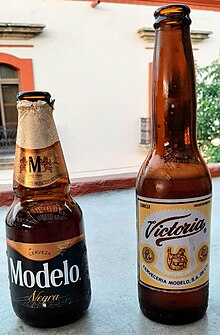 History of beer in Mexico dates from the Spanish conquest of the Aztec Empire. While Mesoamerican cultures knew of fermented alcoholic beverages, including a corn beer, long before the 16th century, European style beer brewed with barley was introduced with the Spanish invasion soon after Hernán Cortés's arrival. Production of this beer here was limited during the colonial period due to the lack of materials and severe restrictions and taxes placed on the product by Spanish authorities. After the Mexican War of Independence, these restrictions disappeared, and the industry was permitted to develop. Furthermore, the arrival of German immigrants during the ephemeral Second Mexican Empire of elected Maximilian I of Mexico, born an Austrian archduke, in the 19th century provided the impetus for the opening of many breweries in various parts of the country. By 1918, there were 36 brewing companies, but over the 20th century, the industry consolidated until today, only two corporations, Grupo Modelo (now owned by AB InBev) and Cervecería Cuauhtémoc Moctezuma formerly known as FEMSA Cerveza (now owned by Heineken N.V.) control 90% of the Mexican beer market. This industry is one of the most prevalent in the country, with over 63% of the population buying one brand or another. Beer is also a major export for the country, with most going to the United States, but is available in over 150 countries worldwide. In 2022, Mexico was the largest beer exporter in the world. (Full article...)
General imagesThe following are images from various Mexico-related articles on Wikipedia.
CategoriesTopicsRelated portalsWikiProjectYou are invited to participate in WikiProject Mexico, a WikiProject dedicated to developing and improving articles about Mexico. Associated WikimediaMore portals | ||||||||||




